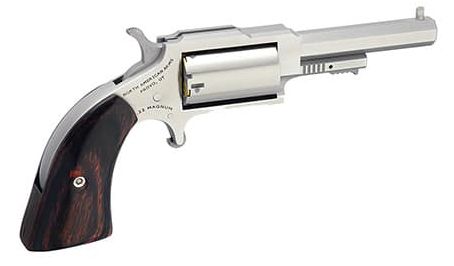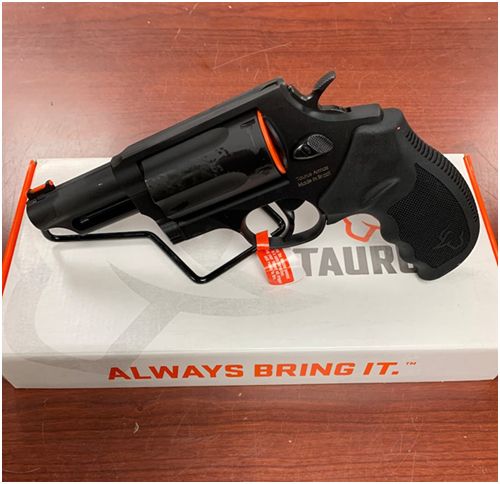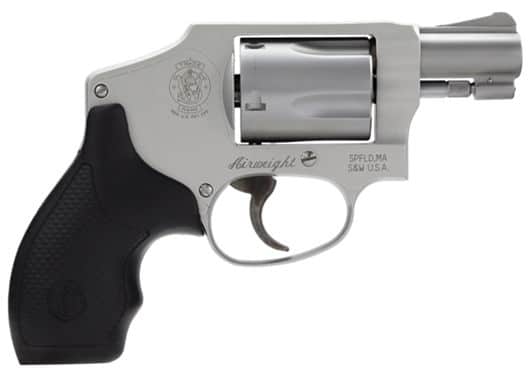At a Glance: The Best Beginner Revolvers
- OUR TOP PICK: Ruger GP100 in .357 Magnum
- Ruger LCRx Revolver
- BEST BUDGET OPTION: North American Arms 1860 Sheriff Boot Grip Revolver
Comparison of The Best Beginner Revolvers
| PRODUCT | DETAILS | ||
|---|---|---|---|

Our Top Pick
|
Ruger GP100 in .357 Magnum |
|
View Latest Price |
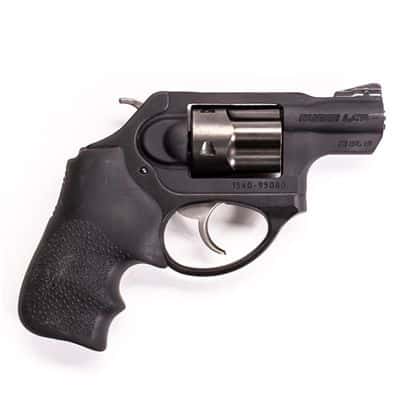
Our Top Pick
|
Ruger LCRx Revolver |
|
View Latest Price |
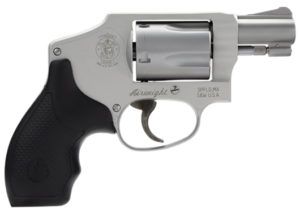
Our Top Pick
|
Smith & Wesson 642 Airweight |
|
View Latest Price |
While the performance benefits of semi-automatic handguns are undeniable, there is a certain level of simple elegance to revolvers. Revolvers are not only a nostalgic throwback but can also serve as a great introductory weapon for new shooters. There are still dozens of revolvers in production today due to their popularity and benefit to new shooters. This wealth of choices can make it difficult to find the right gun for you, which is why we have compiled a list of the Best Beginner Revolvers.
Our Top 5 Best Beginner Revolvers on the Market Today
Whether you are looking for a bedside home defense gun or concealed carry revolvers, our review has an option for you. Picking the right revolver can be a bit confusing at first, especially if you don’t have much experience with them.
We have done all the heavy lifting and broken down every aspect of these revolvers, including the caliber of the round they fire and their frame size so that you can choose the right gun for your goals.
Ruger GP100 in .357 Magnum
First up on our list of Best Beginner Revolvers is the Ruger GP100 chambered in .357 magnum. The GP100 comes in a black, corrosion-resistant finish and has a 4.2″ barrel. It has Hogue grips with finger grooves, which allows for a firm grip, even when shooting with gloves.
As with all revolvers chambered in .357 magnum, the GP100 can also fire .38 Special rounds. This is because the two rounds are of near-identical diameter, but the .357 magnum rounds are longer and more powerful. On the other hand, revolvers chambered in .38 Special cannot accept .357 rounds because the chambers in the cylinder are shorter and not rated for the additional pressure of the stronger rounds.
The GP100 is the epitome of reliable simplicity. It can easily be disassembled without any tools and allows for accurate shots on a consistent basis thanks to its barrel length. The longer barrel does have its drawbacks, such as making this revolver difficult to carry concealed.
The GP100 also has a very long trigger pull when the hammer is not pre-emptively cocked backward. Once the hammer is cocked, the trigger pull is extremely crisp. A long pull on the first shot is commonplace with revolvers, but the GP 100’s seems especially drawn out. Otherwise, it is a great all-around revolver chambered in an extremely effective round.
Pros
- Accurate
- Chambered for powerful .357 magnum rounds
- Can fire .38 Special rounds, which are easier to buy in bulk
- Tool less disassembly
Cons
- Long first trigger pull
- Difficult to carry concealed
Ruger LCRx Revolver
Our second entry is the Ruger LCRx revolver chambered in .38 Special. The LCRx has an aluminum frame and stainless-steel cylinder, which results in a lightweight but durable pistol. It has Hogue grips that aid in reducing the amount of recoil.
The LCRx is geared towards concealed carry applications and weighs just over 1 pound unloaded. It has a very manageable 1.87″ barrel and a short, minimized hammer to avoid accidental snags on your clothing. The clip-on IWB (inside the waistband) holster is included with the revolver. You can also purchase a Ruger laser sight that is specially made for this revolver series.
As with our first pick, the LCRx’s first trigger pull is double-action, meaning that the hammer moves backward and then releases forward when it hits the breaking point. The long first trigger pull can be negated by preemptively cocking the hammer, but the first pull is relatively crisp and has a clean break.
The LCRx’s short barrel does come at a cost. I found this revolver to be inaccurate outside of about five yards, which is fine for personal defense applications. However, if you are looking for a dual-purpose or home defense revolver, I would recommend an option with a longer barrel.
Pros
- Lightweight
- Optional Laser
- Holster Included
- Crisp trigger pull
- Short hammer
Cons
- Extremely short barrel
- Not great for home defense applications
- Not rated for .357 magnum rounds, only .38 Special
North American Arms 1860 Sheriff Boot Grip Revolver
Coming up next is one of my personal favorite revolvers on our list. The North American Arms 1860 “Sheriff” is a single action revolver with a Rosewood boot grip. It is chambered in .22 magnum and holds five rounds.
The Sheriff is just over 6″ long and weighs less than half a pound unloaded, making it a versatile concealed carry gun suitable for any outfit. The .22 magnum rounds produce a negligible amount of recoil, allowing even the most inexperienced shooters to comfortably fire this revolver. I like to carry my mini revolver when I’m sporting gym shorts that would be weighed down by a heavier gun.
The downside of the Sheriff is the short barrel and caliber, which makes it a poor choice for home defense applications. However, most self-defense incidents outside the home involve the aggressor being in close proximity to their potential victim, which is where the Sheriff is most effective. Plus, the bad guy isn’t going to stop and check the size and caliber of the gun you pull on them.
Pros
- Compact
- Lightweight
- Minimal Recoil
- Rosewood grips
Cons
- Minimal Range
- Not suitable for home defense
Taurus 45/410 Judge
Our fourth pick is the Taurus Judge. The Judge is an excellent home defense revolver that is chambered in .45 Long Colt. The model featured above has a 3″ barrel and weighs 29 ounces, but Taurus makes several other variations with different barrel lengths. All models hold five total rounds.
The Judge’s claim to fame is that it can also fire 2 ½ inch .410-gauge shotgun shells as well as the .45 LC rounds. Being able to fire small gauge shotgun shells out of a revolver platform allows you to have even more firepower at your fingertips. I like to mix and match .45 and .410 rounds for a little extra fun at the range.
The Judge’s added weight helps to absorb a good amount of the recoil created by the high caliber rounds, but the shortest barreled version still kicks like a mule. With that in mind, I wouldn’t recommend going any shorter than the 3″ barrel. If you plan on using it exclusively as a bedside gun for home protection, then you could consider one of Taurus’ 6.5-inch barrel options.
In addition to being a good home protection gun, it makes an excellent trail gun or sidearm for hunting trips. The .410 shells are good for killing snakes or other small dangerous animals that you may encounter in the field. Guns that exclusively fire .410 shells are aptly referred to as “snake charmers” for this reason.
Pros
- Fires two calibers
- Great stopping power
- Good for home defense
Cons
- Heavy
- Size makes concealed carry impractical
- Lots of recoil
Smith & Wesson 642 Airweight
Our fifth and final entry is the S&W 642 Airweight. The 642 is a stainless-steel revolver chambered in .38 SPL +P. It has a 5 round capacity and weighs just under one pound unloaded. The barrel comes in at just under 2″ and the entire gun is only 6.3″ long.
The 642 is one of S&W’s hugely popular “J” framed revolvers, meaning that it has a no-show hammer to eliminate the chance of accidental snags. This design means that the hammer cannot be pre-cocked and leaves the revolver functioning as a double-action handgun only. No worries though because the 642 has a crisp and relatively short trigger pull that breaks cleanly every time.
The .38 SPL +P ammunition fired by this revolver packs a little more punch than standard .38 SPL ammo but is not quite as strong as .357 magnum rounds. The 642 can fire standard .38 SPL rounds as well, which are a little easier to buy in bulk and are great for range trips where you are going to be doing a lot of shooting.
The 642 is a solid choice for new shooters because it is easy to use and care for. It fires a strong enough round to offer good stopping power without creating a huge amount of recoil. As with other short, barreled revolvers, its accuracy is limited to about five yards but the 642 is so well suited for concealed carry in all other aspects that it’s tough to overlook this sleek-looking revolver.
Pros
- Internal Hammer
- Weighs under 1 pound
- Chambered in .38 SPL +P
- Stainless steel is corrosion resistant
Cons
- Extremely short barrel
- Double-action only
Why a Revolver?
I can’t count the number of times that I’ve received a puzzled look from a new shooter when I suggest that they look into revolvers. Their initial confusion is quickly followed by one of several common responses that brings up the ammo capacity or barrel length of the revolver as a negative. That plus revolvers don’t look nearly as flashy as some more modern semi-automatics do.
Chances are, you have probably even asked yourself “Why should I buy a revolver?” at some point while reading this article. To answer this question, let’s start by addressing some of the common concerns pertaining to revolvers.
Are 6 Rounds Enough?
Not surprisingly, most citizens that carry concealed never have to fire their weapon in self-defense. Even those that do aren’t engaging in a full-fledged firefight that involves multiple mag changes and the firing of dozens of rounds of ammunition. This means that the five or six-round capacity of your average revolver is plenty to protect you and your family when you are out and about.
In fact, most violent assailants flee the scene anytime they encounter resistance from the potential victim. Criminals are looking for an easy win, which usually means snatching a purse or relieving you of your wallet.
Is a Revolver Accurate Enough For Self Defense?
As mentioned in our review section, several of the shorter barreled revolvers are only accurate up to about five yards. For the purposes of this review, that means that I was able to consistently put rounds on a silhouette target from this distance. The shot grouping varied from weapon to weapon, but all rounds were on the target and most were pretty soundly placed near center mass.
I know that the five-yard line may seem pretty short, but there is a method to the madness. The reason that I chose this cut-off distance is that the average shooting involving citizens that carry a concealed firearm occurred from a distance of fewer than fifteen feet. In fact, the average shooting distance of police officer-involved incidents is only about seven yards. Using this distance as our metric, I can confidently say that the revolvers featured on our list are plenty accurate for personal protection.
What Is A Good Starter Revolver?
If you are looking at making your first handgun purchase, the chances are that your primary goals are for self-defense and home protection. Most people buying their first handgun are not looking to jump into competitive shooting but are simply looking to learn the basics of marksmanship and firearms safety.
A revolver’s primary benefit to new shooters is its simplicity.
They are easy to load and shoot, which flattens the steep learning curve for those that are inexperienced with firearms. Perhaps more importantly, they are easy to maintain. I find that many shooters buying a gun exclusively for protection have more success with revolvers as their introductory handgun.
How Does A Revolver Work?
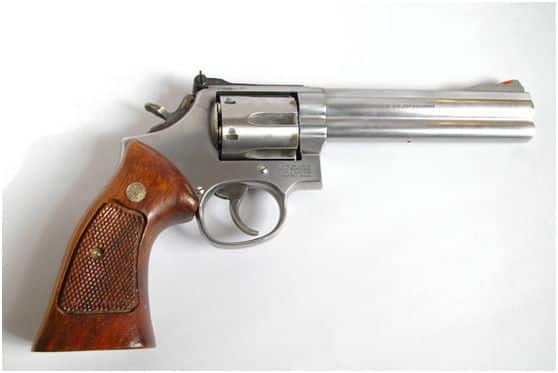
The real beauty of revolvers is their simple and timeless design, which results in them being extremely reliable. Revolvers were the first multi-shot pistol and were invented by Samuel Colt in 1835. While they have certainly improved with time, the basic premise and function have remained largely unchanged.
Revolvers, which were once called “wheel guns”, consist of a rotating cylinder that typically holds five or six rounds. However, some revolvers chambered in smaller calibers such as .22 LR can hold eight or more rounds. When the trigger is pulled, the cylinder rotates and aligns the round with the barrel. Each trigger pull rotates the cylinder and aligns the next rounds.
Unlike semi-automatic handguns, revolvers do not eject the empty casing once the round is fired. The empty casings must be dumped during reloading. This is done by depressing a button on the frame of the revolver, which allows the cylinder to shift out to one side.
Many revolvers also have a rod protruding from the center of the cylinder that can be pressed to aid in ejecting the spent casings. With some smaller revolvers, the cylinder completely detaches from the frame during the loading process. I prefer the style that remains connected to the frame, but that choice really comes down to personal preference as opposed to performance benefits.
Revolvers, like all other handguns, also have some form of a hammer. Most revolvers have an exposed hammer, which can be manually cocked to shorten the trigger pull of the first shot. The hammer is released during the trigger pull. The hammer strikes the primer of the round, igniting the powder and firing your bullet.
What to Look for When Buying Your First Revolver
Choosing the right revolver for you is a pretty straight forward process.
The two main factors that you should consider before making your decision are the caliber and barrel length of the revolver. These factors will affect how much recoil the gun exerts and also how hard it is to conceal. Longer barrels and larger calibers can provide good results in terms of accuracy and stopping power but will affect concealability.
Caliber
When I am looking for a revolver or any handgun for that matter, I like to strike a good balance between caliber and frame size. The smaller caliber revolvers are going to provide minimal recoil and generally result in a smaller frame. However, there is a trade-off between recoil and stopping power.
Smaller rounds, such as the .22 magnum, will create very little recoil but do not have a huge amount of stopping power. Any handgun round can be deadly but having some weight behind your round is important for self-defense. On the other hand, a revolver that fires an extremely powerful round like the .45 Long Colt will provide great stopping power but also a huge recoil.
If possible, I recommend going to your local range and renting a few guns that are chambered in various calibers. Shooting guns chambered in various calibers will give you a strong sense of the amount of recoil that each round produces and help you decide which is right for you. Larger framed shooters typically lean towards larger rounds and vice versa but being able to make accurate shots and being comfortable shooting your firearm is extremely important.
Barrel Length
Once you find a caliber that you are comfortable with, choosing the right barrel length is your next step. When looking at semi-automatic handguns, the barrels tend to get shorter as you reduce frame size. Revolver sizes are a little different. Many companies will offer a particular revolver model with varying barrel lengths.
For instance, the Judge has been manufactured in 2.5″, 3″, and 6.5″ barrel lengths, but the rest of the frame is nearly identical. Having an option in barrel lengths is great for accommodating shooters of different body types that want to carry a larger caliber revolver. Keep in mind that the shorter barreled revolvers will not have as long of an effective range though and will typically produce more recoil.
I find that the mid-sized barrels tend to suit me best. The long 6″ + barrels can be very cumbersome and uncomfortable to carry concealed. A barrel around 3″ seems to offer a sufficient amount of accuracy while also being manageable to conceal with a reasonable wardrobe.
What Kind of Ammo Does a Revolver Use?
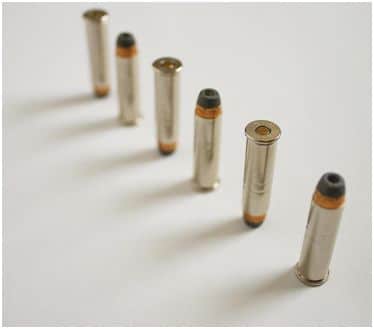
Due to key design differences, the ammo used for revolvers is usually different than that used for semi-automatic handguns. The cylinder of a typical revolver warrants the use of ammunition that has longer cartridges than magazine-fed handguns. The most common of these ammunitions is .38 Special, which is almost 10 mm longer than 9mm handgun ammo.
Another common round used for larger caliber revolvers is .45 LC. The .45 LC cartridge is longer than that of .45 ACP, which is used for semi-automatic handguns such as the 1911. This trend continues with other rounds like the .357 magnum and .44 magnum.
Common revolver cartridges and the semi-automatic counterparts are very similar in diameter, but these differences in cartridge length make it important that you purchase and use the correct ammunition for your gun. This similarity in diameter makes it possible for the wrong rounds to be placed in your revolver. For example, a 9mm round will fit in most .38 SPL revolvers and will probably even fire. However, they will not fit properly in the barrel and will likely damage your revolver.
Best Revolver to Buy for Beginners
All of the revolvers featured in our list are excellent options for new shooters. The one revolver that stands above the rest is the Airweight 642 by S&W. The J framed revolver provides good stopping power with its .38 SPL +P ammunition without producing wrist breaking recoil. S&W packed in just enough modernization while leaving the utility of the revolver intact.


